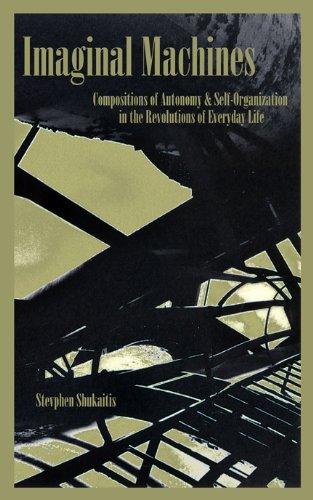Stevphen Shukaitis: Imaginal Machines: Autonomy & Self-Organization in the Revolutions of Everyday Life (2009)
Filed under book | Tags: · avant-garde, everyday, left, life, machine, philosophy, politics, revolution, social movements

“All power to the imagination? Over the past forty years to invoke the imagination as a basis for radical politics has become a cliché: a rhetorical utilization of ideas already in circulation, invoking the mythic unfolding of this self-institutionalizing process. But what exactly is radical imagination? Drawing from autonomist politics, class composition analysis, and avant-garde arts, Imaginal Machines explores the emergence, functioning, and constant breakdown of the embodied forms of radical imagination.
What does it mean to invoke the power of the imagination when it seems that the imagination has already seized power through the power of the spectacle? Does any subversive potentiality remain? Perhaps it is only honest to think in terms of a temporally-bounded subversive power. It might be that imaginal machines only work by breaking down. That is, their functioning is only possible, paradoxically, by their malfunctioning. By reopening the question of recuperation, the inevitable drive to integrate the power of social insurgency back into the working of capital and the state, we create possibilities for a politics continually reconstituted against and through the dynamics of recuperation: to keep open an antagonism without closure.”
Publisher Minor Compositions, London/NYC/Port Watson, 2009
ISBN 1570272085, 9781570272080
255 pages
PDF (updated on 2016-2-21)
EPUB (added on 2016-2-21)
ARG (added on 2016-2-21)
Scribd
Nikos Papastergiadis: Spatial Aesthetics: Art, Place and the Everyday (2006/2010)
Filed under book | Tags: · art, art history, contemporary art, everyday, life

This book examines the most recent shifts in contemporary art practice. By working with artists and closely observing the way in which they relate to urban space and engage other people, locally and globally, Nikos Papastergiadis provides a critical account of the transformation of art and public culture. He shows art has sought to democratise the big issues of our time and utilize new information technologies. While the concept of the everyday highlights the potential for transformation at the level of the individual, at the same time it has to be seen as a critique of broader structures; in this book Papastergiadis stresses the importance of situating a work within art history as well as relating it to its social context. Spatial Aesthetics will help artists, curators and cultural workers think about the ways they intervene in public life. Challenging recent declarations in the art world that theory is obsolete, it seeks to show how art uses ideas, and how everyone can be involved in the ideas of politics and art.
Originally published by Rivers Oram Press, 2006.
Publisher: Institute of Network Cultures, Amsterdam 2010
Theory on Demand series, No. 5
Creative Commons Attribution Noncommercial No Derivative Works 3.0 Netherlands License
ISBN 9789081602136
135 pages
PDF (updated on 2012-9-3)
Comment (0)Jacques Rancière: The Emancipated Spectator (2008/2009)
Filed under book | Tags: · art, audience, life, philosophy, political art, spectatorship

The foremost philosopher of art argues for a new politics of looking.
The theorists of art and film commonly depict the modern audience as aesthetically and politically passive. In response, both artists and thinkers have sought to transform the spectator into an active agent and the spectacle into a communal performance.
In this follow-up to the acclaimed The Future of the Image, Rancière takes a radically different approach to this attempted emancipation. First asking exactly what we mean by political art or the politics of art, he goes on to look at what the tradition of critical art, and the desire to insert art into life, has achieved. Has the militant critique of the consumption of images and commodities become, ironically, a sad affirmation of its omnipotence?
First published as Le spectateur emancipe, Editions La Fabrique, 2008
Translated by Gregory Elliott
Publisher Verso, 2009
ISBN 184467343X, 9781844673438
134 pages
PDF (no OCR; updated on 2012-7-14)
PDF (no OCR; essay published in Artforum magazine, March 2007; updated on 2012-7-14)

